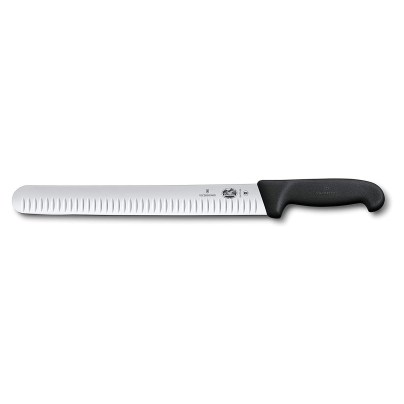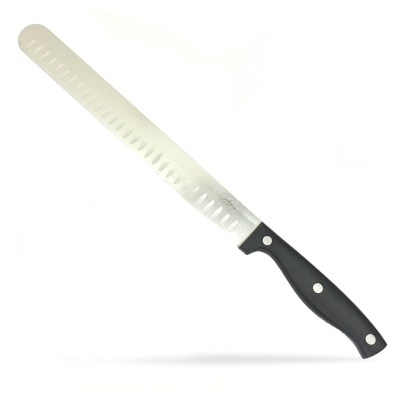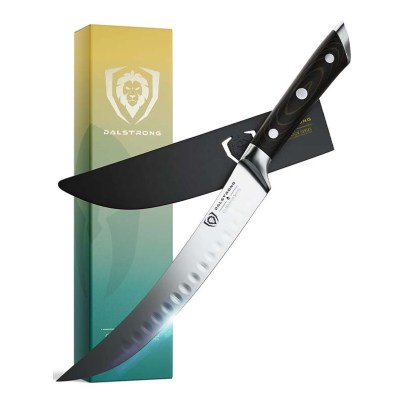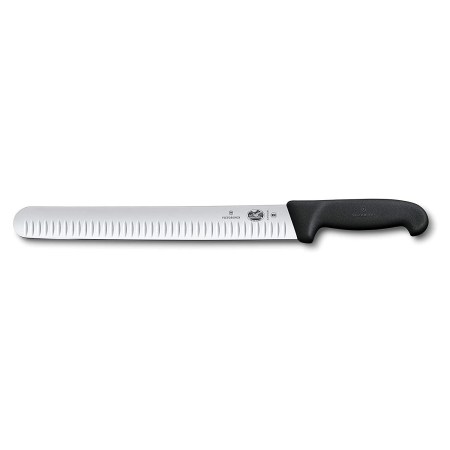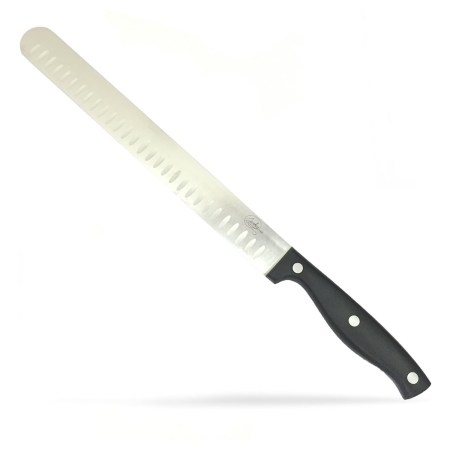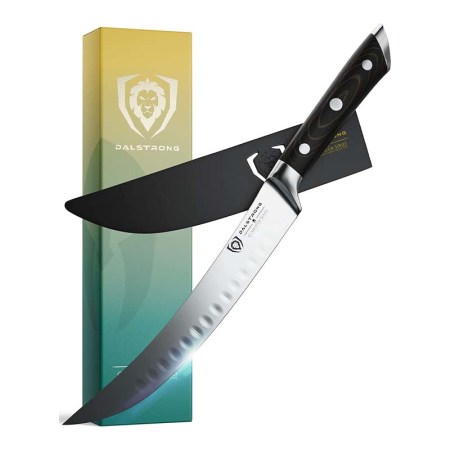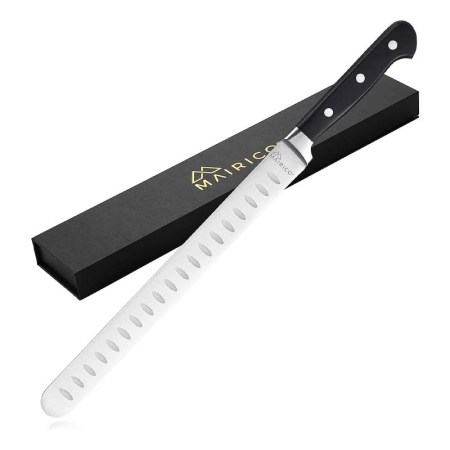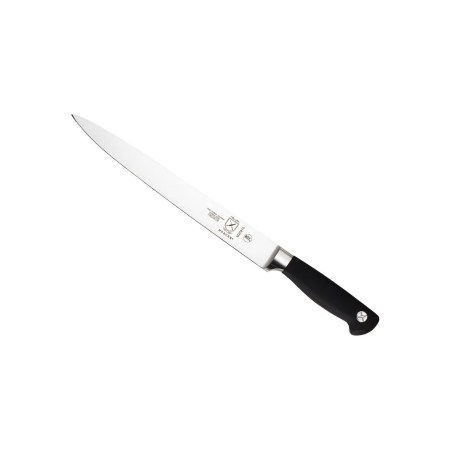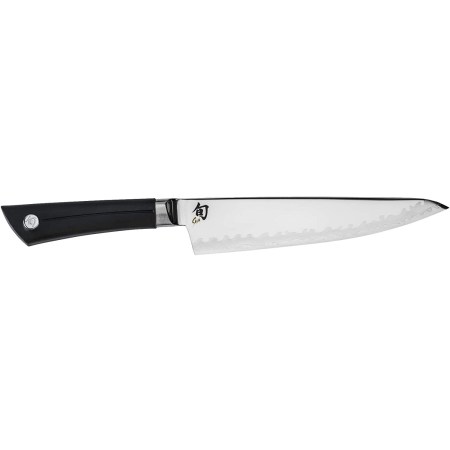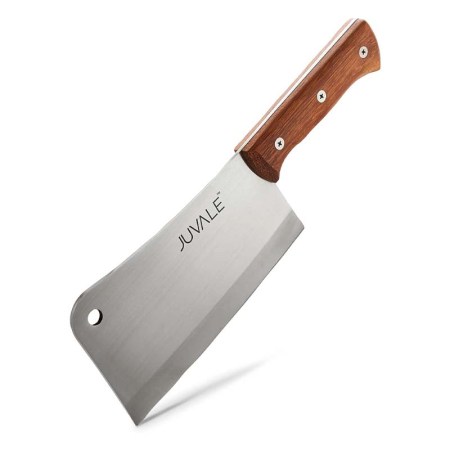We may earn revenue from the products available on this page and participate in affiliate programs. Learn More ›
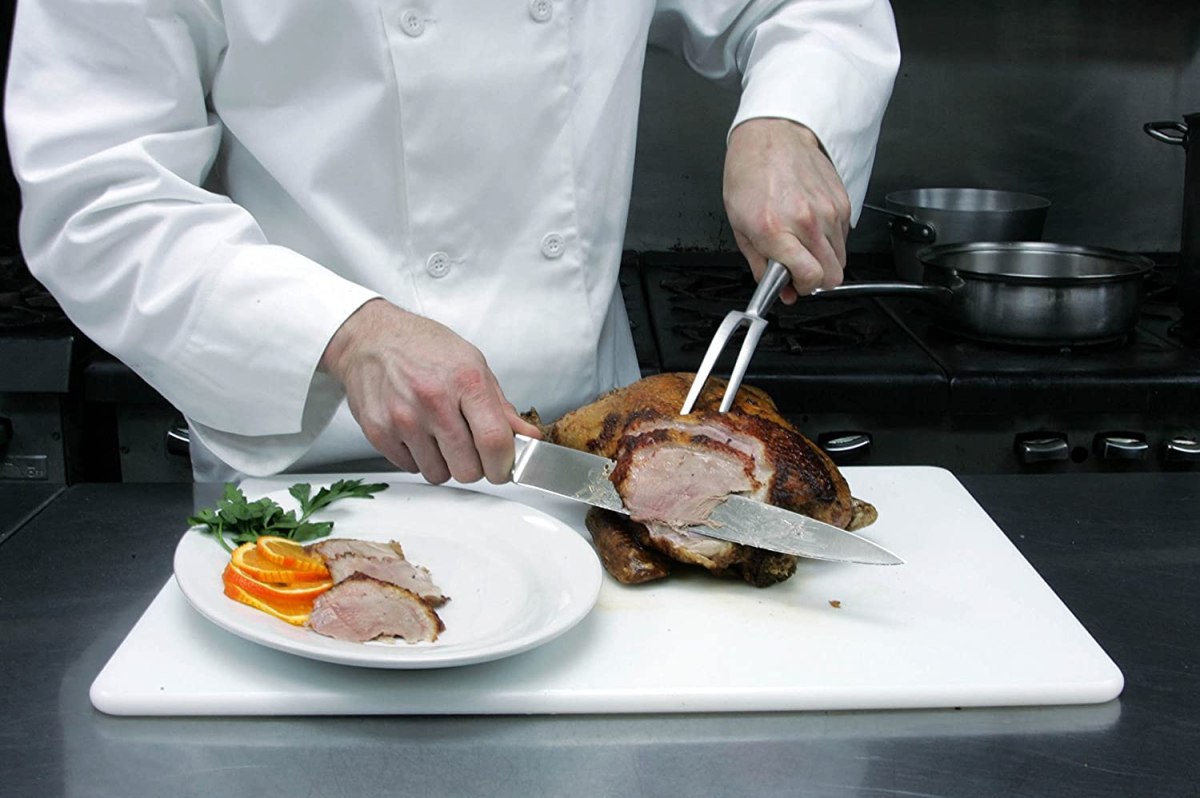
In the world of cutlery, each knife has a specific purpose and design. But when it comes to cutting meat properly, there’s a set of criteria to consider when choosing the best knife, including size, weight, and material.
The best knife for cutting meat is sturdy and well made, sharp enough to glide through meat easily, and properly balanced. Keep reading to learn more key features to consider when shopping, and then explore options for the best knife on the market for cutting meat. An in-depth review of the market and thorough product vetting went into assembling the list of top picks.
- BEST OVERALL: Victorinox Pro Slicing Knife with Granton Blade
- BEST BANG FOR THE BUCK: Professional 10-Inch Carving Knife
- UPGRADE PICK: Dalstrong Butcher Breaking Cimitar Knife
- BEST PROFESSIONAL: Mairico Ultra Sharp Stainless Steel Carving Knife
- BEST CARVING: Mercer Culinary Genesis Carving Knife
- BEST JAPANESE: Shun Sora 8-Inch Japanese Chef’s Knife
- BEST FOR CUTTING BONES: Juvale Stainless Steel Meat Cleaver Knife
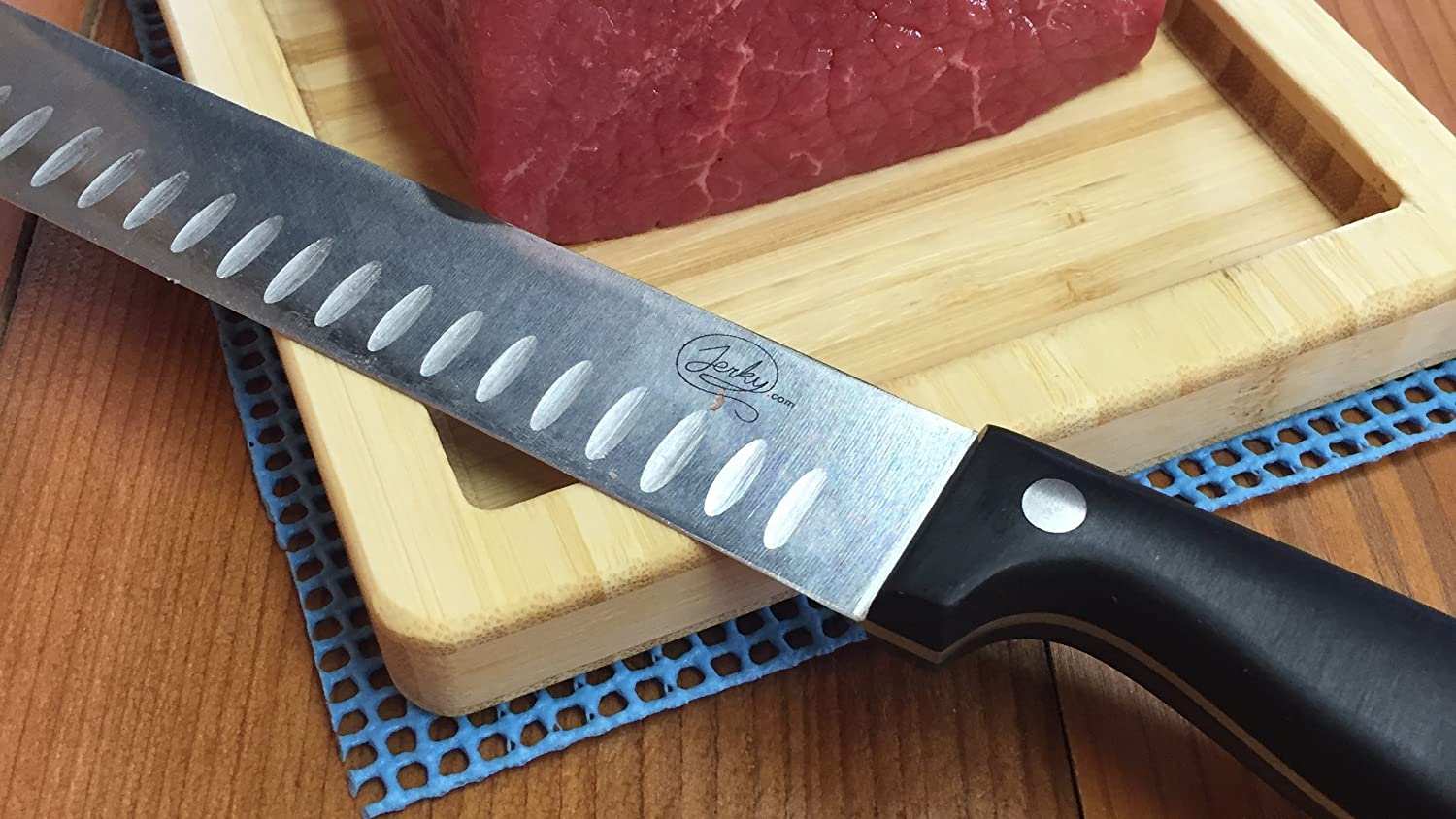
What to Consider When Choosing the Best Knife for Cutting Meat
When shopping for the best kitchen knife for cutting meat, it’s important to consider certain criteria. The knife’s weight, for example, should suit the user’s preferences as a cook. Some prefer a heavier knife while others look for a lightweight option, and the size and/or length of a knife should be comfortable for the user to work with. The blade should be designed to feel well balanced and secure when holding the knife, and the handle should be easy to grip and not slippery.
Weight
A knife for cutting meat should weigh enough for the user to feel comfortable. Some prefer the knife to be heavier so that gravity assists with cutting, making the knife glide through the meat. Others like a more lightweight option, as lighter knives are easier to maneuver and direct through each piece of meat, whatever the size.
To clarify a bit more, although two knives may weigh the same, they may feel different in the hand to different users. Using a knife that feels comfortable to the user will give the best results.
Size
The best size knife for the user will depend on the size of the user’s hand, the tasks the knife will be used for, and personal preference. Whatever the size of the blade, the knife should be comfortable for the user to maneuver as needed, with consideration given to the tasks to be completed.
A smaller paring knife of about 6 inches is ideal for working with small foods, such as peeling an apple or slicing a clove of garlic. An 8-inch knife is more versatile for household cooking and prepping tasks, while a 10-inch or longer blade can be useful for larger items such as pumpkins or watermelons.
Blade
Different types of knife blades are designed to cut through different types of foods. The basics of these include:
- Plain-edge blades: Most knives in any kitchen are likely to have plain-edge blades. These are designed to be straightforward, cutting a clean slice through either hard or soft foods without fraying them as they cut.
- Serrated-edge blades: Serrated blades have edges similar to a saw. They are jagged and can vary in the size of the teeth along the edge of the blade. These types of blades are useful for cutting thick or hard foods, such as loaves of bread with tough crusts or certain thick-skinned fruits and vegetables.
- Hollow-edge blades: Hollow-edge blades have indentations just above the edge. The indentations are designed to create micro air bubbles that enable a cleaner cut, preventing the food being cut from sticking to the blade. Often seen on household carving knives, this is useful when the goal is thin slices of meat.
- Granton blades: Granton is a well-known knife company in Sheffield, England, but it can also refer to a type of blade edge. These blades have rows of scallops on both sides, which create mini air pockets between the food being cut and the blade. This air allows the food to release from the blade easily, keeping it from ripping and tearing, which is useful in cutting meats, fish, cheese, and other such foods.
Handle
Knife handles can be made from wood, plastic, stainless steel, or other materials. Each type of material has pros and cons, which should be considered before purchasing any knives.
- Wood handles: Though wooden handles are generally considered the most attractive-looking knife handles, they are also harder to care for. For example, they require hand-washing (they’re not water-resistant) as well as occasional mineral-oil treatments.
- Plastic handles: Although plastic handles are more easily cared for than wood handles, they can also be prone to splitting or becoming brittle due to ultraviolet damage over a lengthy period. Plastics can also become slippery in one’s hand during use, which can be dangerous when cutting meats or other foods.
- Stainless steel handles: Stainless steel handles are considered the most sanitary as well as the most durable type of handle, but they can get slippery when wet. Sometimes, for this reason, there may be additional indentations or ridges along the handle to create more places to grip. Also, stainless steel knives from blade to handle can be exceptionally heavy, which some knife makers have remedied by crafting hollow handles.
Our Top Picks
With these factors in mind, the following list of top-quality knives in various categories can help users determine which would work for their specific meat-cutting needs.
Best Overall
Victorinox Pro Slicing Knife with Granton Blade
See ItThis knife has features that make cutting meat easier, such as the air pockets in its Granton blade, which lessen friction while cutting. The Granton blade also ensures that food doesn’t stick to it, and the nonslip, thermoplastic rubber grip stays dry even when the user’s hands get wet.
Users can also feel comfortable using this knife for cutting other foods besides meat. With a sturdy yet thin and remarkably lightweight blade, users will be able to wash it either by hand or in the dishwasher. Make sure to sharpen this knife about every 3 months to keep it from getting dull.
Product Specs
- Materials: Stainless steel and thermoplastic rubber
- Blade type: Granton
- Length: 12 inches
Pros
- Air-pocketed blade
- Nonslip, thermoplastic rubber grip
- Lightweight
- Can be washed by hand or put in the dishwasher
Cons
- Requires sharpening every 3 months
Get the Victorinox Pro slicing knife on Amazon or at Sears.
Best Bang For The buck
Professional 10-Inch Carving Knife
See ItDon’t be deceived by the bargain price on this gem. It’s high quality and cuts through meat like butter. It’s known as the jerky slicing knife among the jerky-making professionals who designed it.
The carving knife’s balanced design encourages simple, uniform cuts for each batch of jerky, and it also makes for evenly cut slices of other types of meat. The knife has a comfort-fit handle and comprises solid food-grade steel, which means it’s also great for cutting foods other than meat. Best of all, it’s dishwasher-safe. Be sure to wash and dry it at once if hand-washing, as it may be prone to rust if left wet for too long.
Product Specs
- Materials: Food-grade steel
- Blade type: Granton
- Length: 10 inches
Pros
- Balanced design
- Ergonomic, comfort-fit handle
- Dishwasher-safe
Cons
- Prone to rust if not dried quickly
- Some users report poor quality
Get the Professional 10-Inch carving knife on Amazon.
Upgrade Pick
Dalstrong Butcher Breaking Cimitar Knife
See ItProfessional chefs, as well as avid foodies, can appreciate the Dalstrong Butcher Breaking Cimitar Knife. Though expensive, this unique razor-sharp knife is made for breaking, sectioning, and portioning thick or thin slices of meat. Made with high-tang, high-carbon German steel, this 8-inch-long hollow-edge blade is tempered and stain-resistant. The blade edge has also been hand-sharpened with 14- and 16-degree angles on either side for precision and ease of use.
This 8-ounce knife has a highly impervious, triple-riveted, military-grade fiberglass resin handle to last for years and has been certified by the NSF (formerly the National Sanitation Foundation). It also comes in multiple sizes depending on the user’s cutting needs.
Product Specs
- Materials: High-carbon German steel
- Blade type: Hollow edge
- Length: 8 inches
Pros
- High-quality materials
- Tempered, stain-resistant blade
- Hand-sharpened to 14 and 16 degrees
- Certified by the NSF
- Comes in multiple sizes
Cons
- Heavier than comparable options
- Pricey
- Some users report rusting
Get the Dalstrong butcher knife on Amazon or at Sears.
Best Professional
Mairico Ultra Sharp Stainless Steel Carving Knife
See ItFor the advanced cook or professional chef, a professional tool is needed for cutting large roasts or steak, or even for carving a turkey. That’s why our top pick for professional use is the Mairico Ultra Sharp Stainless Steel Carving Knife. This 11-inch Granton blade is made with German stainless steel for longevity and has full tang and triple fastening for cutting with minimal effort.
The ergonomically designed nonslip handle and balanced weight also make this knife perfect for frequent and professional use.
Product Specs
- Materials: Stainless steel
- Blade type: Granton
- Length: 11 inches
Pros
- Ultrasharp, full-tang blade
- Ergonomically designed nonslip handle
- Balanced weight distribution
Cons
- Heavier than comparable options
- No blade cover included for storing
Get the Mairico Ultra carving knife on Amazon.
Best Carving
Mercer Culinary Genesis Carving Knife
See ItAnother product of precision-forged German steel, this knife combines top-notch strength and durability. Let precise meat carving commence with this NSF-certified carving knife featuring a safety-grip Santoprene handle. Its long-lasting sharpness and quality design can help up anyone’s carving game. The nonslip grip is comfy and ergonomic, keeping the handle safe even when it gets wet. Moreover, this knife will resist discoloration, corrosion, and stains over time, maintaining a great look for one’s kitchen collection.
This knife won’t break down with exposure to temperatures of either extreme. It is highly durable and has been tested and held to safety, performance, and quality standards by the NSF.
Product Specs
- Materials: High-carbon steel
- Blade type: Plain edge
- Length: 10 inches
Pros
- Durable blade
- High-temperature resistance
- Resists damage and discoloration
- Nonslip grip
- NSF certified
Cons
- Heavier than comparable options
Get the Mercer carving knife on Amazon or at Sears.
Best Japanese
Shun Sora 8-Inch Japanese Chef’s Knife
See ItJapanese-style knives are said to be lighter and have thinner blades than other types of knives, which allow for greater maneuverability and the ability to slice foods finely. Handcrafted in Japan, the Shun Sora Chef’s Knife is handcrafted with proprietary steel.
This chef’s knife’s handle reflects a traditional Japanese design while its blade is nonserrated and hand-sharpened. Shun knives are heat treated, making their blades stronger and harder with greater durability. To prevent extensive damage, this knife must be hand-washed; it cannot be placed in the dishwasher.
Product Specs
- Materials: Steel
- Blade type: Hollow edge
- Length: 8 inches
Pros
- Traditional Japanese design
- Heat-treated blade
- Extra-light and thin construction
Cons
- Shorter than comparable options
- Not dishwasher-safe
Get the Shun Sora chef’s knife at Amazon, The Home Depot, or Target.
Best for Cutting Bones
Juvale Stainless Steel Meat Cleaver Knife
See ItCutting through meat is easy enough with most knives, but harder materials, such as bone and cartilage, are a little tougher to cut through while preparing a meal. That’s where a large cleaver, or breaker, can help.
The dishwasher-safe Juvale Stainless Steel Meat Cleaver Knife could be just the ticket for tricky cutting and portioning with its full-tang stainless steel blade. This 8-inch plain-edge blade has a 6-inch wooden handle, making it one of the longest knives on this list. This heavy-duty pick also has a hanging hole for easy storage on a peg or hook.
Though it can take on several tough tasks while cutting meat, this knife is the heaviest top pick we have come across at 1.9 pounds.
Product Specs
- Materials: Stainless steel and wood
- Blade type: Plain edge
- Length: 14 inches
Pros
- Full-tang blade
- Hanging hole
- Suitable for cutting meat, bones, and cartilage
- Dishwasher-safe
- Affordable
Cons
- No nonslip grip
- Some users report poor durability in the handle
Get the Juvale cleaver knife on Amazon or at Target.
Our Verdict
If you are looking for an easy-to-use knife for cutting meat, look no further than the Victorinox Pro slicing knife. This lightweight, air-pocketed, 12-inch blade provides limited friction while cutting and has a nonslip, thermoplastic rubber grip for safety while in use.
Alternatively, for professional chefs and cooks, the hollow-edge Dalstrong butcher knife is made with high-carbon German steel, making it stain-resistant and durable for cutting and portioning. Plus, its 8-inch blade is certified by the NSF.
How We Chose the Best Knives for Cutting Meat
We researched the most sought-after meat knives in their respective categories and discovered that the best models are determined by their materials, blade type, size and weight, and other special features included by top brands.
While searching for the best knives for cutting meat, the most popular types among users were the plain-edge, Granton, and hollow-edge knife blades with stainless steel, high-carbon steel, and food-grade steel. Many of these knives also come with rubber or triple-tempered fiberglass nonslip handles, while others have wooden handles for a pleasing aesthetic.
As for ease of use and maneuverability, we incorporated chef’s knives ranging in length from 8 to 14 inches and in weight from 1 ounce to 1.9 pounds for different cutting tasks. For added convenience, select knives on our list are made with hanging holes, are sharpened or made by hand, or have been heat treated or tempered for maximum durability and longevity. Moreover, select options require minimal sharpening and maintenance.
FAQs
For those who are new to shopping for knives for cutting meat, it’s natural to have questions. Buyers should take their time making a decision and make sure they’re happy with their purchase once they receive it. Here are answers to some frequently asked questions about the best knives for cutting meat.
Q. What knives do professional butchers use?
For their trade, professional butchers use a combination of knives constructed with high-quality materials. High-carbon stainless steel is desirable for cutting meat, and a full tang (meaning the blade runs through the full length of the handle) helps the knife feel balanced as it cuts through the meat.
A variety of knives, such as cimeter knives, butcher knives, cleavers, boning knives, and breaking knives, are popular, with each type having different qualities to help butchers achieve their ideal cuts of meat.
Q. What kind of knife do you use to cut a beef tenderloin?
Either a very sharp fillet knife or a boning knife is the best choice for cutting beef tenderloin. A small paring knife can also work, but it may have difficulty cutting through because the blades are quite short.
Q. How often do you need to sharpen a knife for cutting meat?
Most home cooks would say professionally sharpening your knives once every 3 to 6 months is sufficient.
